6.3 The Shell Method
Often a given problem can be solved in more than one way. A particular method may be chosen out of convenience, personal preference, or perhaps necessity. Ultimately, it is good to have options.
The previous section introduced the Disk and Washer Methods, which computed the volume of solids of revolution by integrating the cross-sectional area of the solid. This section develops another method of computing volume, the Shell Method. Instead of slicing the solid perpendicular to the axis of rotation creating cross-sections, we now slice it parallel to the axis of rotation, creating “shells.”
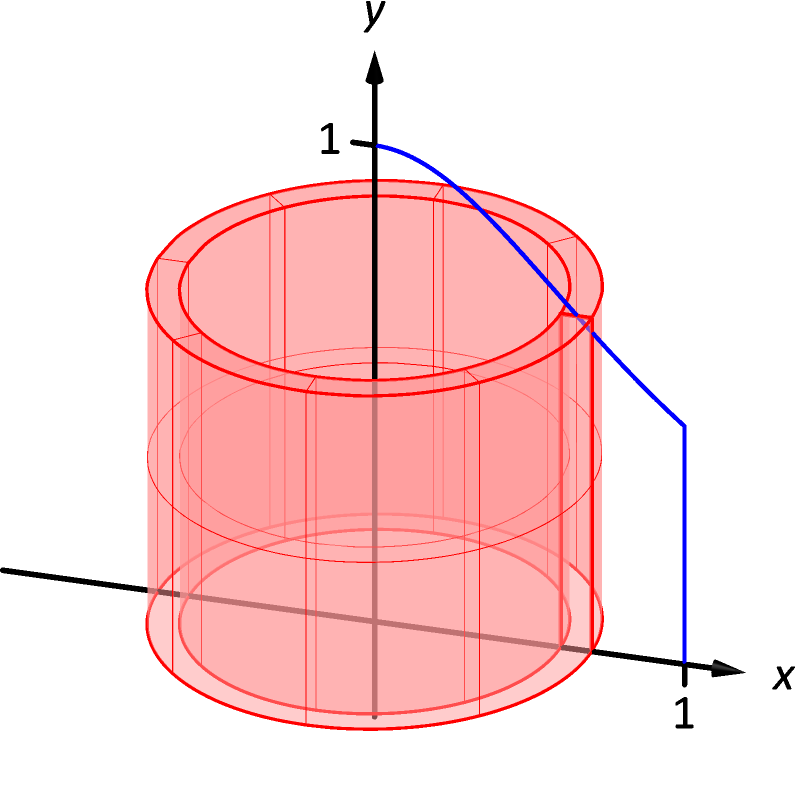 (b)
(b)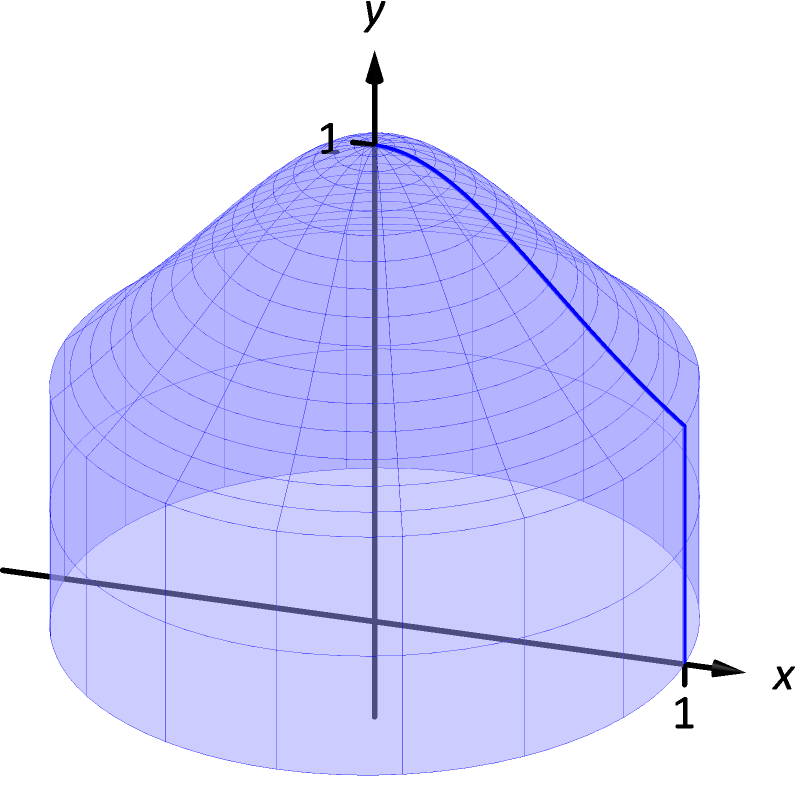 (c)
Figure 6.3.1: Introducing the Shell Method.
(c)
Figure 6.3.1: Introducing the Shell Method.
Consider Figure 6.3.1, where the region shown in (a) is rotated around the -axis forming the solid shown in (c). A small slice of the region is drawn in (a), parallel to the axis of rotation. When the region is rotated, this thin slice forms a cylindrical shell, as pictured in part (b) of the figure. The previous section approximated a solid with lots of thin disks (or washers); we now approximate a solid with many thin cylindrical shells.
To compute the volume of one shell, first consider the paper label on a soup can with radius and height . What is the area of this label? A simple way of determining this is to cut the label and lay it out flat, forming a rectangle with height and length . Thus the area is ; see Figure 6.3.2(a).
Do a similar process with a cylindrical shell, with height , thickness , and approximate radius . Cutting the shell and laying it flat forms a rectangular solid with length , height and depth . Thus the volume is ; see Figure 6.3.2(b). (We say “approximately” since our radius was an approximation.)
By breaking the solid into cylindrical shells, we can approximate the volume of the solid as
where , and are the radius, height and thickness of the shell, respectively.
This is a Riemann Sum. Taking a limit as the thickness of the shells approaches 0 leads to a definite integral.
| (a) | (b) |
Key Idea 6.3.1 The Shell Method
Let a solid be formed by revolving a region , bounded by and , around a vertical axis. Let represent the distance from the axis of rotation to (i.e., the radius of a sample shell) and let represent the height of the solid at (i.e., the height of the shell). The volume of the solid is
Special Cases:
-
1.
When the region is bounded above by and below by , then .
-
2.
When the axis of rotation is the -axis (i.e., ) then .
Let’s practice using the Shell Method.
Example 6.3.1 Finding volume using the Shell Method
Find the volume of the solid formed by rotating the region bounded by , , and about the -axis.
SolutionThis is the region used to introduce the Shell Method in Figure 6.3.1, but is sketched again in Figure 6.3.3 for closer reference. ††margin: Figure 6.3.3: Graphing a region in Example 6.3.1. A line is drawn in the region parallel to the axis of rotation representing a shell that will be carved out as the region is rotated about the -axis.
The distance this line is from the axis of rotation determines ; as the distance from to the -axis is , we have . The height of this line determines ; the top of the line is at , whereas the bottom of the line is at . Thus . The region is bounded from to , so the volume is
| This requires substitution. Let , so . We also change the bounds: and . Thus we have: | ||||
Note: in order to find this volume using the Disk Method, two integrals would be needed to account for the regions above and below .
With the Shell Method, nothing special needs to be accounted for to compute the volume of a solid that has a hole in the middle, as demonstrated next.
 (b)
(b)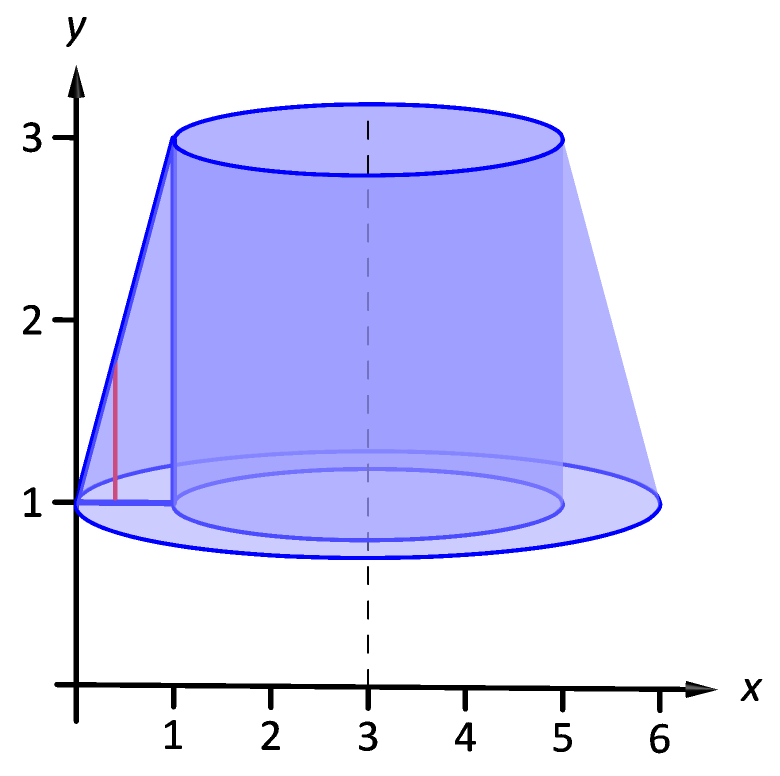 (c)
Figure 6.3.4: Graphing a region in Example 6.3.2.
(c)
Figure 6.3.4: Graphing a region in Example 6.3.2.
Example 6.3.2 Finding volume using the Shell Method
Find the volume of the solid formed by rotating the triangular region determined by the points , and about the line .
SolutionThe region is sketched in Figure 6.3.4(a) along with a line within the region parallel to the axis of rotation. In part (b) of the figure, we see a sample shell, and in part (c) the whole solid is shown.
The height of the sample shell is the distance from to , the line that connects the points and . Thus . The radius of the sample shell is the distance from to ; that is, it is . The -bounds of the region are to , giving
When revolving a region around a horizontal axis, we must consider the radius and height functions in terms of , not .
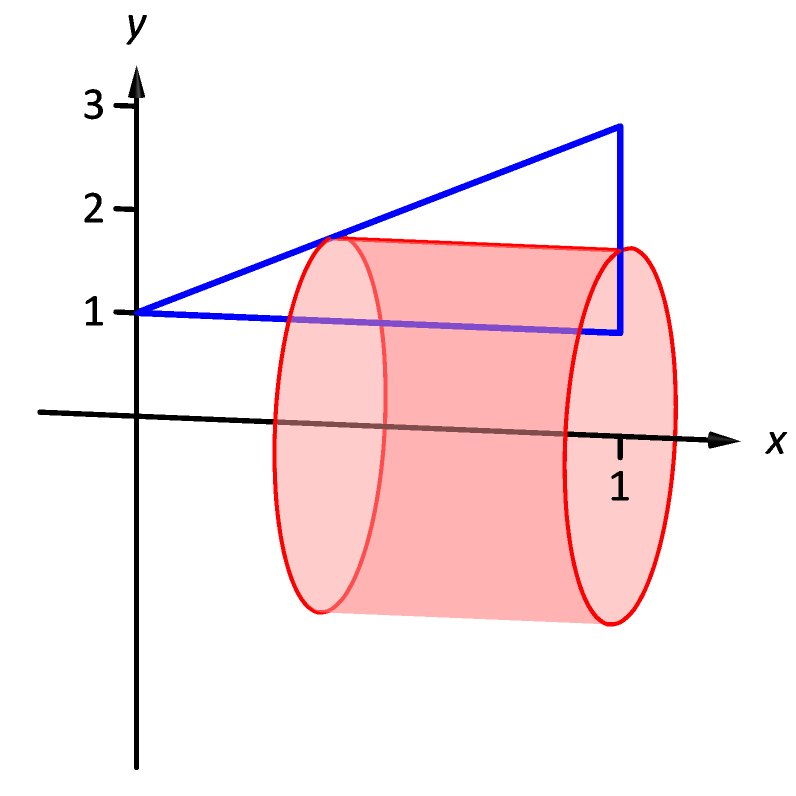 (b)
(b)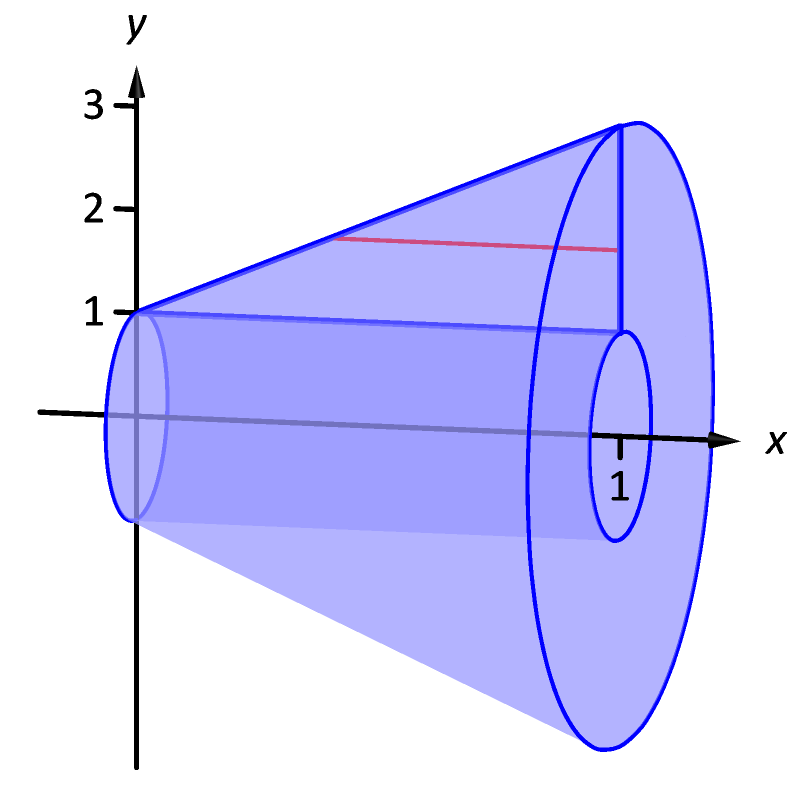 (c)
Figure 6.3.5: Graphing a region in Example 6.3.3.
(c)
Figure 6.3.5: Graphing a region in Example 6.3.3.
Example 6.3.3 Finding volume using the Shell Method
Find the volume of the solid formed by rotating the region given in Example 6.3.2 about the -axis.
SolutionThe region is sketched in Figure 6.3.5(a). In part (b) of the figure the sample shell is drawn, and the solid is sketched in (c). (Note that the triangular region looks “short and wide” here, whereas in the previous example the same region looked “tall and narrow.” This is because the bounds on the graphs are different.)
The height of the sample shell is an -distance, between and . Thus The radius is the distance from to the -axis, so . The bounds of the region are and , leading to the integral
The following example shows how there are times when it does not matter which method you choose to evaluate the volume of a solid. In Example 6.2.7 we found the volume of the solid formed by rotating the region bounded by and about . We will now demonstrate how to find the volume with the shell method. Note that your answer should be the same whichever method you choose.
Example 6.3.4 Using the shell method instead of the washer method
Find the volume of the solid formed by rotating the region bounded by and about using the Shell Method.
SolutionSince our shells are parallel to the axis of rotation, we must consider the radius and height functions in terms of . The radius of a sample shell will be and the height of a sample shell will be . The bounds for the region will be to resulting in the integral
At the beginning of this section it was stated that “it is good to have options.” The next example finds the volume of a solid rather easily with the Shell Method, but using the Washer Method would be quite a chore.
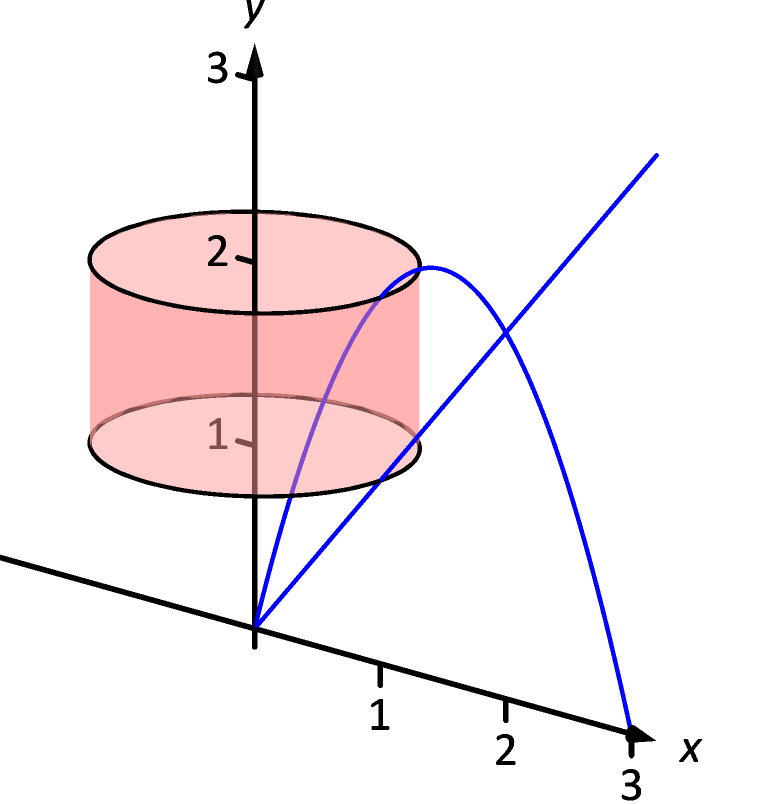 (b)
(b)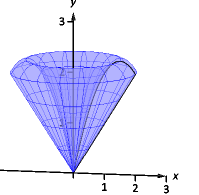 (c)
Figure 6.3.6: Graphing a region in Example 6.3.5.
(c)
Figure 6.3.6: Graphing a region in Example 6.3.5.
Example 6.3.5 Finding volume using the Shell Method
Find the volume of the solid formed by rotating the region bounded by and about the -axis.
SolutionThe region, a sample shell, and the resulting solid are shown in Figure 6.3.6. The radius of a sample shell is ; the height of a sample shell is . The bounds on the region are to leading to the integral
Note that in order to use the Washer Method, we would need to solve for , requiring us to complete the square. We must evaluate two integrals as we have two different sample slices. The volume can be computed as
While this integral is not impossible to solve, using the Shell Method gave us a significantly easier way to compute the volume.
We finish with an example where we can use either method to find the volume.
Example 6.3.6 Finding volume using the Washer Method and the Shell Method
Find the volume of the solid formed by rotating the region bounded by the curves , , , and about the y-axis using both the washer method and the shell method.
SolutionWe’ll start with the shell method, since that turns out to be easier. The region, a sample shell, and the resulting solid are shown in Figure 6.3.7 parts a, b, and e respectively. The volume is
With the washer method, we need to integrate with respect to because we are rotating around a vertical axis. We also need to divide the region in two because the washers will run into different boundaries at different heights. We have indicated the region and the two different types of washers in Figure 6.3.7 parts c and d. The volume is
We are reassured to find the same answer using either method.
 |
 |
|
| (a) | (b) | |
 |
||
| (c) | (d) | (e) |
As in the previous section, the real goal of this section is not to be able to compute volumes of certain solids. Rather, it is to be able to solve a problem by first approximating, then using limits to refine the approximation to give the exact value. In this section, we approximate the volume of a solid by cutting it into thin cylindrical shells. By summing up the volumes of each shell, we get an approximation of the volume. By taking a limit as the number of equally spaced shells goes to infinity, our summation can be evaluated as a definite integral, giving the exact value.
Exercises 6.3
Terms and Concepts
-
1.
T/F: A solid of revolution is formed by revolving a shape around an axis.
-
2.
T/F: The Shell Method can only be used when the Washer Method fails.
-
3.
T/F: The Shell Method works by integrating cross-sectional areas of a solid.
-
4.
T/F: When finding the volume of a solid of revolution that was revolved around a vertical axis, the Shell Method integrates with respect to .
Problems
In Exercises 5–8, a region of the Cartesian plane is shaded. Use the Shell Method to find the volume of the solid of revolution formed by revolving the region about the -axis.
-
5.
-
6.
-
7.
-
8.
In Exercises 9–12, a region of the Cartesian plane is shaded. Use the Shell Method to find the volume of the solid of revolution formed by revolving the region about the -axis.
-
9.
-
10.
-
11.
-
12.
In Exercises 13–17, a region of the Cartesian plane is described. Use the Shell Method to find the volume of the solid of revolution formed by rotating the region about each of the given axes.
-
13.
Region bounded by: , and . Rotate about: (a) the -axis (b) (c) the -axis (d)
-
14.
Region bounded by: and . Rotate about: (a) (b) (c) the -axis (d)
-
15.
The triangle with vertices , and . Rotate about: (a) the -axis (b) (c) the -axis (d)
-
16.
Region bounded by and . Rotate about: (a) the -axis (b) (c)
-
17.
Region bounded by , and . Rotate about: (a) the -axis (b) (c) the -axis (d)
In Exercises 18–20, use your choice of the Washer or Shell Method to find the indicated volume.
-
18.
Region bounded by , , and . Rotate about: (a) the -axis (b) the -axis
-
19.
Region bounded by , , and . Rotate about: (a) the -axis (b)
-
20.
Region bounded by and . Rotate about (a) the -axis (b) (c)
